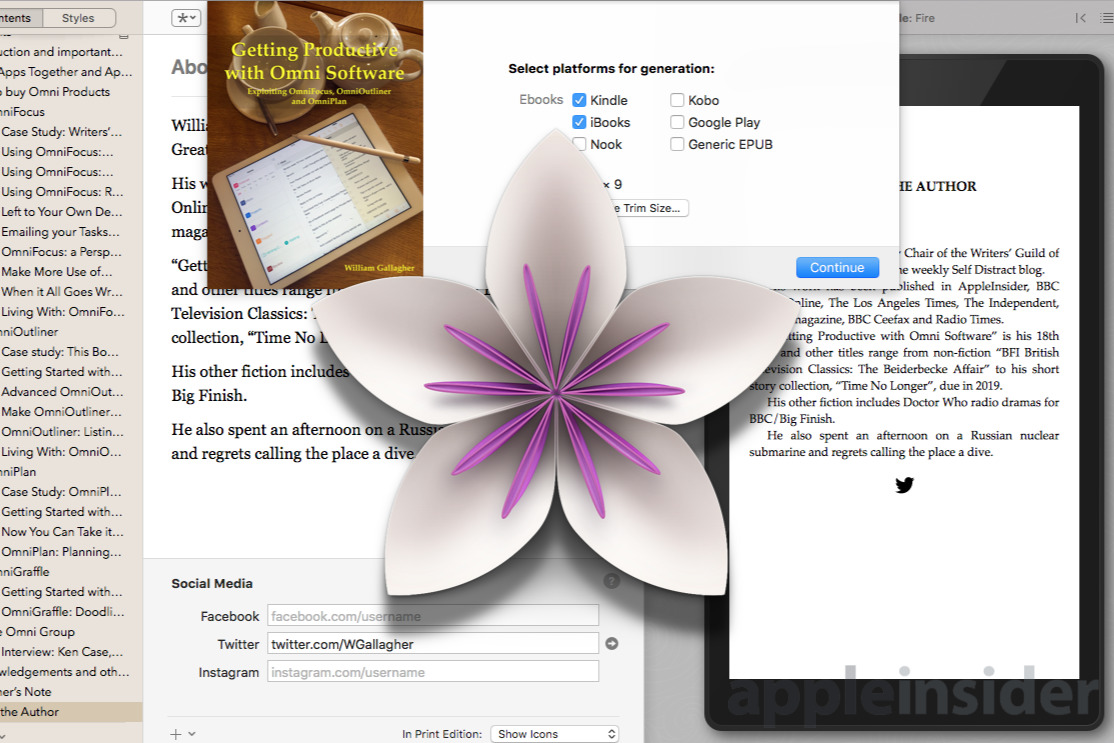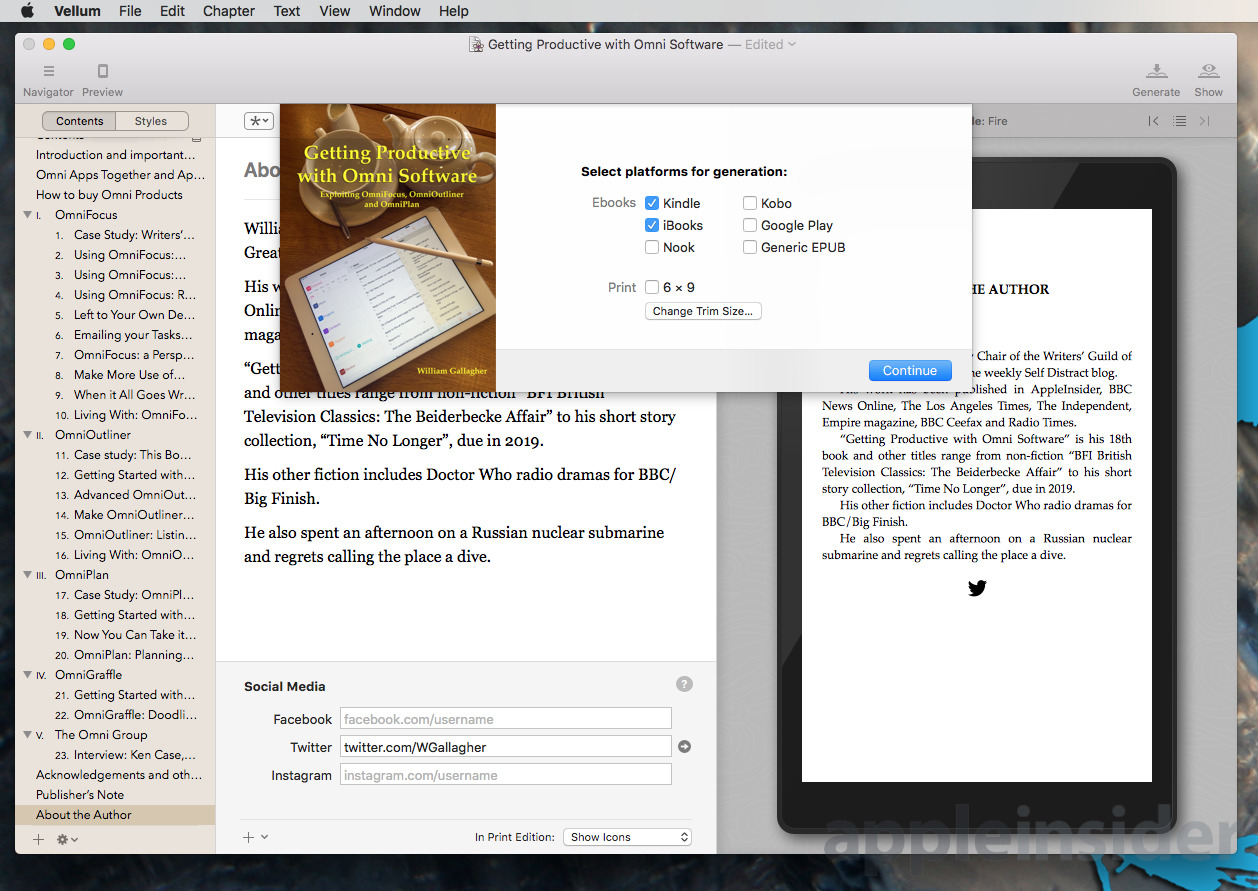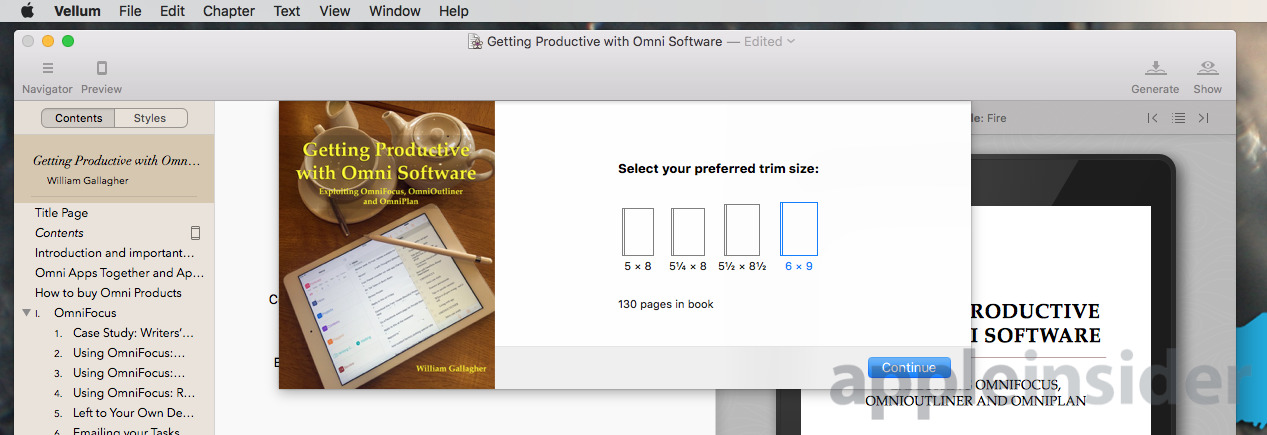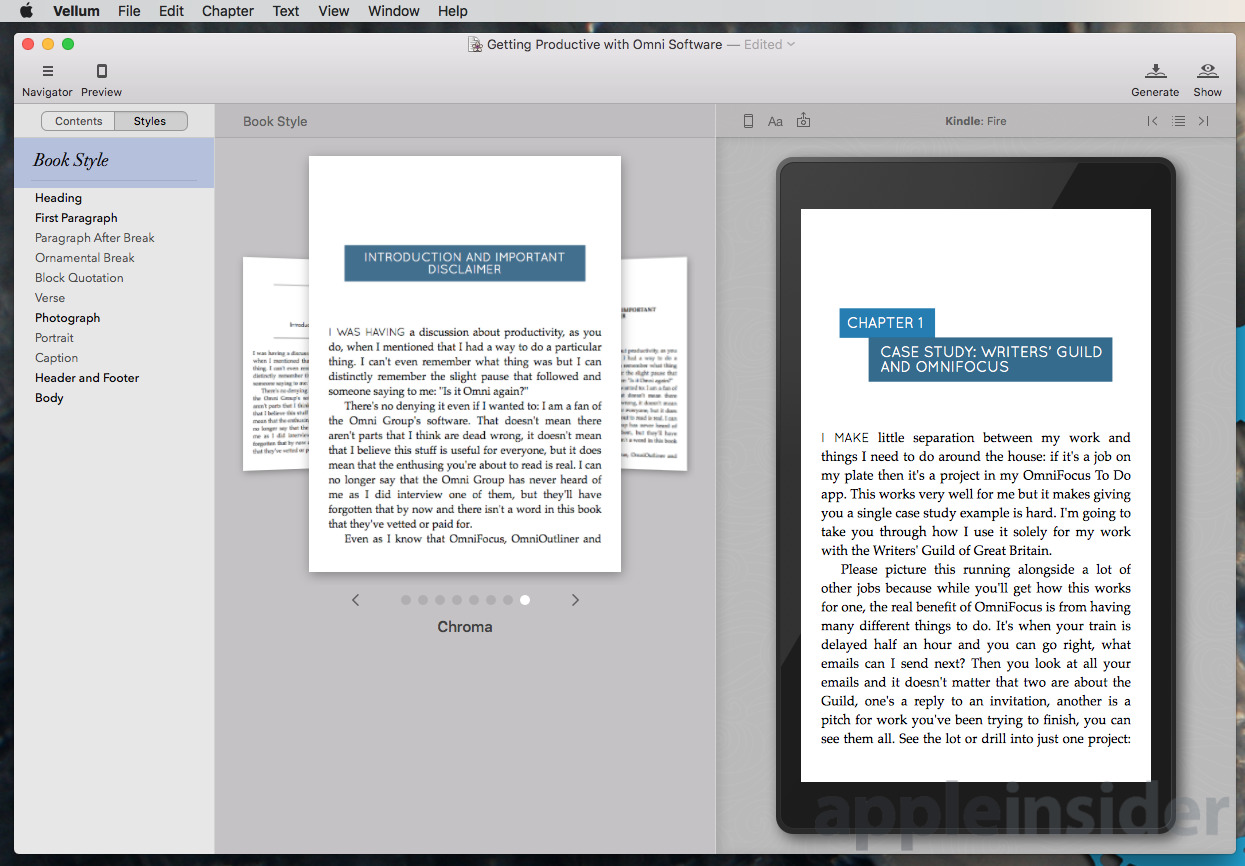The latest version of the eBook creator application Vellum does just about everything to streamline book creation for iBooks, Kindle and paperback, other than write the text itself.
You know that absolutely anyone can self-publish a book now. You've probably read a couple where you wish they'd had an editor. What's not clear until you actually try it, though, is that self-publishing is a fiddly game that's far from straightforward unless you use software designed to help. Vellum 2.1.2 is a gorgeous one of these, and its newest version concentrates on helping you make print books right alongside iBooks, Kindle and other ebook editions.
What's always been fiddly with making books is that you have to juggle different elements in the production - the text itself, the cover design, the page layout and more — and then find your way through the iBooks Store and Amazon. Neither store is that straightforward despite promises to be so, and as a result, neither Vellum or any other tool makes uploading a book a one-click option.
Yet, if you still choose to schlep through Apple's and Amazon's publishing process, Vellum will provide you with the files that you will have to upload. That used to mean two files for each store: a text ePub document and a JPEG cover. You'd have one pair formatted for iBooks, and another for Kindle. If you're so inclined, you can also make files compatible with the Nook and Kobo ecosystems.
Now, Vellum 2.1.2 can produce one more file alongside these: a print-ready PDF. You can then send that PDF to a local printing company or you can upload it to a service like Amazon's print on demand service CreateSpace. Depending on your country there are other online firms, but if you print through CreateSpace it's the work of half a minute to have that book listed for sale on Amazon.
Vellum is an easy app to start working in, but in total, books are hard to produce and the process ends up stress-testing both you and this app. Once upon a time. we wrote books specifically to test out the app and you can read in exhaustive detail how the entire process went through this series of articles. Or, you can skip to the end of the series and see specifically how Vellum fitted into the process from writing to publishing when we cranked out Pointers: iWork Pages, Numbers and Keynote about two years ago.
So, we've got form with Vellum and Vellum has got form with us. Comparing the new Vellum 2.1.2 to the version 1.2.5 we pounded before, we can see how the core has only had one major change — but the app has been greatly refined.
It used to be too easy to make a mistake in a link where you wanted your ebook to refer to another title or a website, for instance. That's been fixed: we couldn't force that mistake even when we tried.
There are more elements to books now, too. You used to have chapters and sections but now you also have specific elements like the blurb for the back cover. Also an About the Author section, a epigraph, an epilogue, Also By and so on. Really these are all just new additions to the templates but they are set up to both look good, and to help you fill out details you typically want in a book.
These new elements and the general refinements of everything would be enough to make this a useful and even delightful update. Yet, it's the one major change that makes this compelling: you can now use Vellum to make print books, paperbacks, right alongside your ebook.
Previously if you wanted a paperback version of your book then you tended to use a different app like InDesign. As well as near enough doubling production time because you were starting from just the text again, we also found we would have problems keeping track of revisions from draft to draft. If we saw a mistake we needed to fix or we wanted to add a new section to our book, we'd have to remember to do it in two apps.
Now with Vellum 2.1.2, we produce one book and it's only at the last stage that we need think about the paperback version.
Adding this ability to make print books has expanded your options on how to use Vellum but the principle is the same: prepare your text, choose certain options and then have the software generate the files you need.
You should really prepare your text in another application. Write your book in Word or Pages or Scrivener because Vellum isn't designed to be a word processor. You could write the whole thing in it and you both can and definitely will make edits in Vellum, but its focus is on design and layout.
It is very focused on those: you are constrained to layouts and designs that Vellum's makers have set. It's a series of templates and actually not a very long series at all. You could go so far as to say the templates are extremely limited but what you get is exquisitely designed. We've tried Vellum on perhaps half a dozen different titles we've published in the last couple of years and for each one we've just stayed with the default template because it's gorgeous.
Pick that or go crazy and look through the other seven main templates, then import your text. Vellum offers chapters, book parts like sections, contents pages, About the Author and so on. There's a live preview option that shows you how it will all look in print and on various iPad, Kindle and other devices.
You will spend a lot of time arranging chapters and dragging in a JPEG or PNG cover. It's easy but it's involved and it's also involving: you find there's more and more you can do but it's rather satisfying to see your text becoming a book.
In version 2.1.2 you see it simultaneously becoming a book and an ebook. It's easy to miss just how slickly Vellum does this: what used to be quite a separate and different job is now a single task with options. For instance, Vellum has a setting for an About the Author page which includes options for social media.
In your ebook, you want to be able to show the Twitter icon, for example, and have readers be able to tap on that to go read your tweets. That's exactly what happens. Yet in your print book nobody can tap anything so Vellum has a simple option to show the full Twitter or Facebook address in the paperback.
When you're done and ready, you press a Purchase button and that's where you hit money. Vellum 2.1.2 is a free app to download but you pay to create your books.
This is something else that has changed with Vellum 2. It used to be that you could choose to pay per individual book or buy the ability to produce as many titles as you want. Now you can only choose the latter: you pay one fee and can then produce as many books as you want.
It does mean that the first book you make is more expensive than it used to be. To make any number of ebooks, you can buy the Vellum Ebooks package which is $199.99. To make any number of ebooks and print titles, you need Vellum Press which costs $249.99.
Neither option is a casual purchase but it's probably reflective of how users of Vellum tend to stick with it. We'll always try other tools, for instance, but since using Vellum 1 this is our automatic preferred choice. It's that because of how well designed Vellum is and how well designed it makes our books look.
We used to use Apple's free iBooks Author which was similarly well designed — but feels dated now and hasn't progressed as much as Vellum has. Plus, iBooks Author is designed to make titles for Apple's iBooks Store and while you can bend it to make other ebooks, it's an unhappy contortion.
At the other end of the scale, we've often used Adobe InDesign to produce print books and that remains our choice when a title is particularly complex or needs a particular design that Vellum doesn't support. InDesign is available through subscription to Adobe Creative Cloud for a minimum of $19.99/month.
There is a part of us that bridles at being forced to use a company's choice of templates, that would like us to be able to fiddle more. Yet we simply don't have the talent of Vellum's designers and if we ever doubt that, we do have Adobe InDesign where we can see it for ourselves.
Then the new pricing means Vellum 2.1.2 won't be something you buy without some thought about your publishing plans. Yet if you are going to be producing more than one book, Vellum is well worth the cost both for how it makes the process a delight and produces books that are a pleasure to read.
Vellum is available directly from the developer 180g. System requirements are relatively light, with it needing macOS El Capitan 10.11 or newer.
 Mike Wuerthele and William Gallagher
Mike Wuerthele and William Gallagher












-m.jpg)






 Marko Zivkovic
Marko Zivkovic
 Christine McKee
Christine McKee
 Andrew Orr
Andrew Orr
 Andrew O'Hara
Andrew O'Hara
 William Gallagher
William Gallagher

 Mike Wuerthele
Mike Wuerthele
 Bon Adamson
Bon Adamson




-m.jpg)



6 Comments
Mike and William, thanks for this. For all the hand-wringing around here with respect to the needs of the "Pro" -- in the end it's really about software. Real-world reports about apps with developers that are engaged and continuing to improve their product are quite useful and a welcome respite from the issues that a writer like DED has to confront.
I tried to use the previous version of Vellum to publish my book and I found it unusable. I could not believe that the simple input from a Word document and recognizing my chapters were not handled properly.
I used easy to distinguish formats for chapter headings but Vellum was still not able to perform that easy job. I had no faith that they could handle the conversion to the various formats for publishing my books.
I published my book using PressBooks and IngramSpark.
Vellum is worth its price easily.
First, if you have someone ghostwrite a book for you, another to format it into Kindle format, and another to format it for CreateSpace printing, a book is going to cost you at least $300 - for one book.
So in comparison, Vellum for unlimited book formatting is worth its price.
Or like me you know the EPub spec and you use Calibre to write a lean, efficient and attractive novel for the iBook Store, learn the process once and repeat it with ease every time thereafter.
If and when I want to publish on Amazon repeat the process. Spending $200 on an editor to publish is nice for people who want no hastles. I'll put that elsewhere.
The first book was a learning curve with the well-formatted HTML5 EPub/iBooks specific headers, adding some unpublished xml specific font embedding features.
My question: Is it possible to produce an index with hot links using this software?